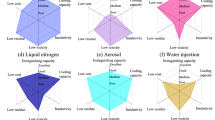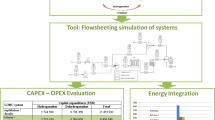Abstract
N,N-Diethyl-hydroxylamine (DEHA) is a novel salt-free reductant used in the reprocessing of spent fuel, this paper reports on γ-rays damage of 0.1–0.5 mol L−1 DEHA irradiated 5–25 kGy and its radiolytic products. DEHA is relative stable against radiation, its radiolysis rate increases with the dose, but decreases with increasing initial DEHA concentration. The main radiolytic products are hydrogen, ethene, methane, acetaldehyde and ammonium ion, their quantities increase with initial DEHA concentration. Hydrogen and liquid radiolytic products quantities increase with the dose, the dependence of hydrocarbon quantity on dose relates to original DEHA concentration and dose.





Similar content being viewed by others
References
Benedict M, Pigford TH, Levi HW (1981) Nuclear chemical engineering. McGraw-Hill Book Company, New York, pp 455–473
Choppin GR, Morgenstern A (2000) The PUREX process, using a solution of 30% TBP in kerosene as the organic phase. Radionuclide separations in radioactive waste disposal. J Radioanal Nucl Chem 243(1):45–51
Jiang ShJ, Ren FY (1995) Nuclear fuel reprocessing technology. Atomic Energy Publisher, Beijing, pp 93–104
Biddle P, Miles JH (1968) Rate of reaction of nitrous acid with hydrazine and with sulphamic acid. J Inorg Nucl Chem 30:1291–1297
Perrott JR, Stedman G (1977) The kinetics of nitrite scavenging by hydrazine and hydrazoic acids at high acid acidities. J Inorg Nucl Chem 39(2):325–327
Dukes EK, Wallace RM (1962) Formation of hydrazoic acid from hydrazine in nitric acid solutions. DP-728:1–15
Schlea CS, Caverly MR, Henry HE, Jenkins WJ (1963) Uranium(IV) nitrate as a reducing agent for plutonium(IV) in the PUREX process. DP-808:1-20
Mckibben JM, Bercaw JE (1971) Hydroxylamine nitrate as a Plutonium reductant in the PUREX solvent extraction process. DP-1248:1–22
Ochsenfeld W, Petrich G (1983) Neptunium decontamination in a uranium purification cycle of a spent fuel reprocessing plant. Sep Sci Technol 18(14&15):1685–1698
Koltunov VS (1998) Stabilization of Pu and Np valences in Purex Process: problems and outlook. In: RECOD’98, the 5th international nuclear conference on recycling, condition and disposal, The French Nuclear Society and the European Nuclear Society, Nice, 425–431
Koltunov VS, Baranov SM, Zharova TP (1993) Kinetics of the reactions of Np and Pu ions with hydroxylamine derivatives (VI)—reaction between Np (VI) and N, N–diethylhydroxylamine. Radiokhimiya 35:79–84
Zhang AY, Liu Y (2000) Hydroxylamine derivative in Purex Process III. The kinetics of oxidation-reduction reaction between N,N-diethylhydroxylamine and neptunium(VI). J Radioanal Nucl Chem 245(2):357–361
Sze K, Gosselin JA (1983) Oxidation of Pu (III) by nitric acid in tri-n-butyl phosphate solutions. Part II. Chemical methods for the suppression of oxidation to improve plutonium separation in contactor operation. Nucl Technol 63:431–441
Wang JH, Wan Y, Wu MH, Bao BR, Sun XL, Zheng WF, Zhang ShD (2008) Analyses of organics in irradiated aqueous N,N-diethyl-hydroxylamine solution. Nucl Sci Tech 19:343–346
Wang JH, Bao BR, Wu MH, Sun XL, Zhang XY, Hu JX, Ye GA (2004) The qualitative and quantitative analysis of the light hydrocarbons produced by radiation degradation of N,N-Diethyl-hydroxylamine. J Radioanal Nucl Chem 262:451–453
Wang JH, Zhang J, Wu MH, Xu G, Bao BR, Sun XL, Zheng WF, He H, Zhang ShD (2011) Radiolytic organics in γ-rays irradiated aqueous solution of N,N-diethylhydroxylamine. Nucl Sci Tech 22(2):95–98
Wang JH, Wang ShX, Bao BR, Li Zh, Li Ch, Zheng WF, Zhang ShD (2008) Gaseous product generated by radiation degradation of N,N-diethylhydroxylamine aqueous solution. Nucl Sci Tech 19(2):79–82
Li HB, Su Zh, Cong HF, Song FL, Wang XR, He H, Liu ZhY, Lin CSh (2012) α and γ irradiation stability of 30%TBP-kerosene-HNO3 systems. J Radioanal Nucl Chem 34(5):280–285
Wu JL, Qi ShCh (1993) Radiation Chemistry. Atomic Energy Publisher, Beijing, pp 156–198
Spinks JWT, Woods RJ (1976) An introduction to radiation chemistry, 2nd edn. Wiley, New York, pp 247–295
Barbara SS, Robert AG Jr (1979) Reactions of diethylhydroxylamine with radiolytically produced radicals in aqueous solution. J Phys Chem 83(13):1696–1701
Ying W (2011) γ Radiolysis of diethylhydroxylamine in nitric acid, pulse radiolysis of diethylhydroxylamine and dimethylhyroxylamine. Dissertation for Master Degree, Shanghai University, 79–102
Adamic K, Bowman DF, Gillan T, Ingold KU (1971) Kinetic applications of electron paramagnetic resonance spectroscopy. I. self-reactions of diethyl nitroxide radicals. J Am Chem Soc 93(4):902–908
Lioret SM, Legua CM, Falco PC (2002) Ammonium determination in water samples by using OPA-NAC reagent: a comparative study with Nessler and ammonium selective electrode methods. Int J Environ Anal Chem 82(7):475–489
Marina MSF, Reis BFD, Fo HB, Baccan N (1992) Flow-injection determination of low levels of ammonium ions in natural waters employing preconcentration with a cation-exchange resin. Anal Chim Acta 261(1–2):339–343
Saigne C, Kirchner S, Legrand M (1987) Ion-chromatographic measurements of ammonium, fluoride, acetate, formate and methanesulphonate ions at very low levels in antarctic ice. Anal Chim Acta 203(1):11–21
Acknowledgments
The authors wish to extend warm acknowledgement for the financial assistance of Natural Science Foundation of China (No. 20771074) and Program for Innovative Research Team in University (No. IRT13078).
Author information
Authors and Affiliations
Corresponding author
Rights and permissions
About this article
Cite this article
Wang, J.H., Wang, C.C., Wang, S.X. et al. γ-ray damage of N,N-diethyl-hydroxylamine in water and its radiolytic products at lower dose. J Radioanal Nucl Chem 309, 503–510 (2016). https://doi.org/10.1007/s10967-015-4641-0
Received:
Published:
Issue Date:
DOI: https://doi.org/10.1007/s10967-015-4641-0




